The island of Funen
SEA TROUT FISHING AS GOOD AS IT GETS
From virtually nothing, on its way to a world-class fishery. Biologist Terkel Broe Christensen tells the good tale of how this came about.

Havørred Fyn is a great example of the success that can be achieved by a public-sector project that works in conjunction with business and the environment. It focuses its efforts on fishing, and its implementation has brought about some of the very best sea trout fishing conditions in the world. This is a well-shaken cocktail of a great idea, politicians with the guts to invest in it, and a strong partnership with fishing enthusiasts. The result is a unique form of recreational fishing that is greatly appreciated by both local and travelling anglers, while also benefiting the environment and, not least, the economy. This article focuses on the background of this project, which has helped inspire similar projects in other locations around the world.
FIRST SOME BACKGROUND
Funen is the third-largest island of Denmark, after Zealand and Vendsyssel-Thy. Funen is linked to Zealand, Denmark’s largest island, by the Great Belt Bridge constructed in the 1930s shortly before World War II. It also connects Funen to the Danish mainland, Jutland. Apart from the main city, Odense, all major towns are located in coastal areas. (As an aside, Funen was also the birthplace of Hans Christian Andersen.)
Up until the 1980s, Funen had no fishing to speak of. In 1967, Danish state biologist Knud Larsen described the situation as: “The part of the country with great rivers for

trout, actually has no trout.” Larsen found that only 9% of the rivers and streams on Funen which he analysed with his electric fishing equipment held trout. This meant the country faced an enormous challenge when it launched a new business development project to establish the ideal conditions for sea trout fishing. The project was so ambitious, it was named “Funen – the Sea Trout El Dorado”.
The project was the brainchild of Jørgen Dan Petersen, in charge of the department of environment, and it was as brilliant as it was simple. Today – 30 years later, and having been renamed Havørred Fyn (which means “Sea Trout Funen”) – the project still works on the same three founding principles: the restoration of Funen’s rivers and streams, the stocking of sea trout to ensure a healthy population in its rivers and streams, and the promotion of Funen as a world-class fishing destination.
Like all business undertakings, the project needs to generate a turnover and create jobs to help the local economy, while being pivotal in the re-establishment of aquatic environments that had previously been neglected. The project’s annual budget of DKK 4.3 million (± R11,472,000) is financed by Funen’s ten municipalities, but essentially it costs Funen’s taxpayers nothing as the turnover is able to generate enough tax revenue to cover the costs. It is a win-win situation, especially when you take into account that the environment is continually being improved.
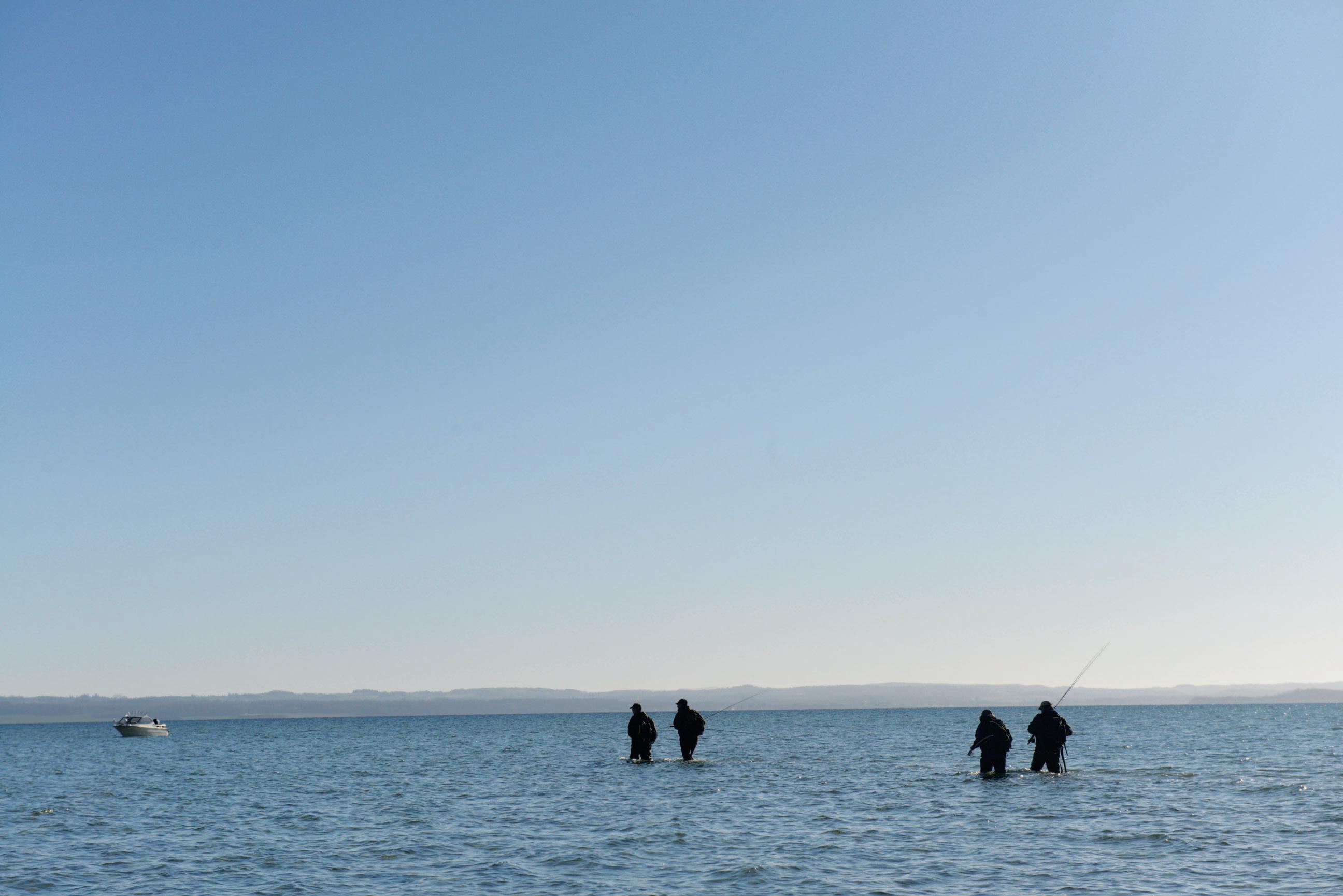
“... THE COUNTRY FACED AN ENORMOUS CHALLENGE WHEN IT LAUNCHED A NEW BUSINESS DEVELOPMENT PROJECT TO ESTABLISH THE IDEAL CONDITIONS FOR SEA TROUT FISHING.”
Below: Shallow water that is perfect for wading in search of sea trout.
IDEAL CONDITIONS FOR COASTAL SEA TROUT FISHING
Funen and its surrounding islands offer a wealth of ideal conditions for coastal sea trout fishing. There is always a spot from where to catch fish, no matter the direction of the wind. If you want to try a different stretch of water, it is less than an hour’s drive from one end of the island to the other; and the fishing spots are diverse: from open and rocky coastal areas to smaller sheltered fjords where you
will often find large numbers of smaller fish. Almost all the coastal stretches are shallow, offering perfect wading conditions for fly anglers.

Perfect conditions aside, paramount to a great fishing experience is that it has to offer robust fish stocks. And you will find plenty to catch along Funen’s coastline, due in no small part to the fact that Havørred Fyn releases 400,000 fry and smolts every year. Research has shown that every

second fish caught was cultured. Another way of putting it would be to say that Havørred Fyn’s programme has made fishing on Funen twice as good as it would have been otherwise. All cultured fish are bred and parented from fish that were electro-fished in Funen’s rivers and streams. Once caught, they are transported to Fyns Laksefisk, a modern recirculated fish farm. Here the roe and sperm of the parent fish are mixed, 18 months later the fertilised eggs develop into fry, which grow and eventually become smolts the following spring, ready for release and life in the salty waters of the shoreline.

RESTORATION OF FUNE N’S RIVERS AND STREAMS
The ultimate objective is to get Funen’s sea trout stocks to the point where they can restock themselves without any assistance from man. The restoration of its rivers and streams is therefore pivotal. Every metre of watercourse
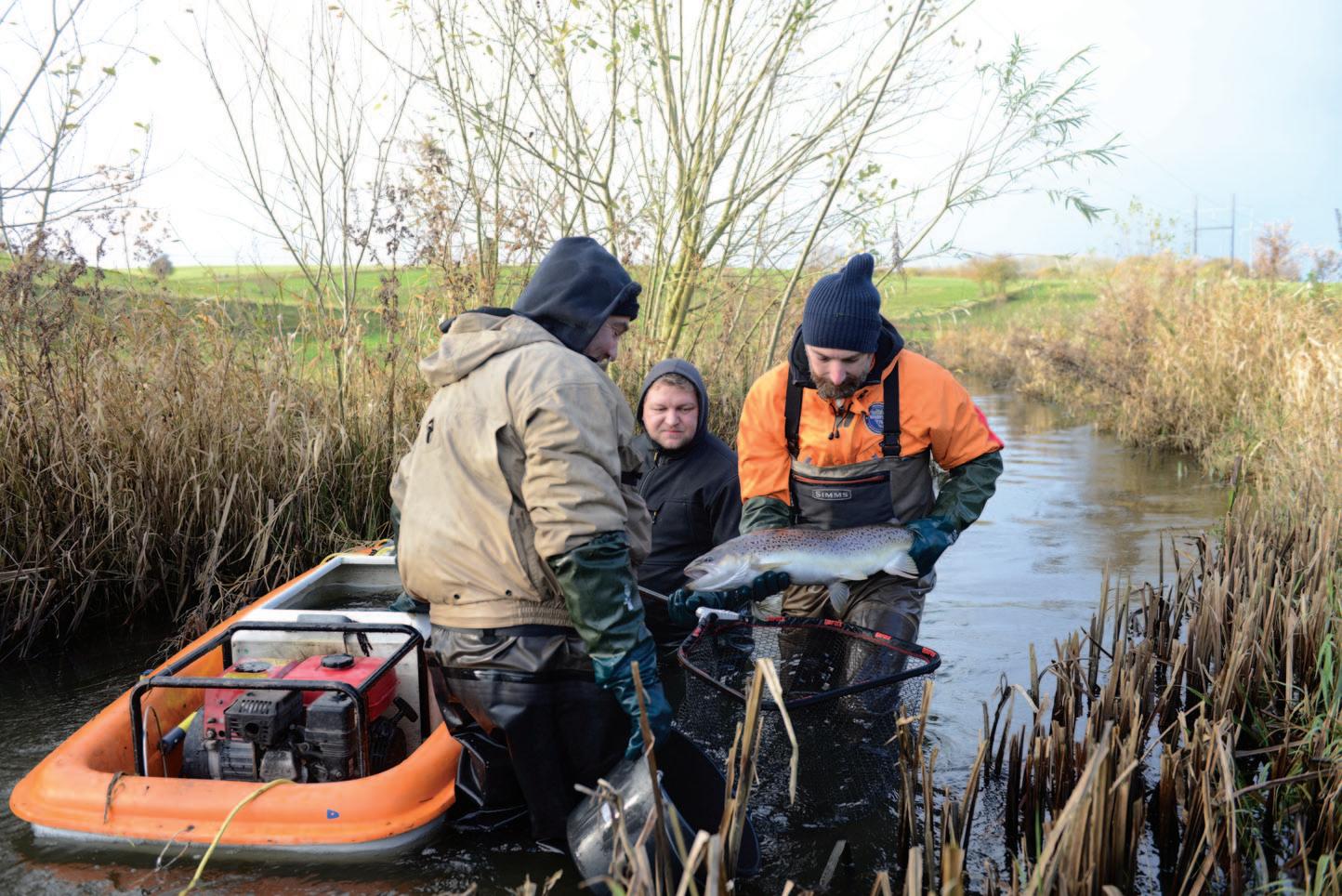
(especially in the narrower upper sections) that’s restored means more wild and robust sea trout stocks will make their way upriver to spawn. Spawning areas in the watercourses are improved by removing dammed obstructions such as old water mills, reopening piped water sections, or rediverting channelled watercourse sections and laying spawning gravel and pebbles. Since 1990, about DKK 2 million has been reserved in the annual budget for watercourse restoration work – and Havørred Fyn has, on average, financed and implemented one watercourse restoration project per month for the past 30 years, for a total of between 350 and 400 projects at a cost of over DKK 40 million. As a result of the ongoing efforts, more than 500km of rivers and streams where fish can spawn have now been opened on Funen and its islands. There are more rivers that need to be restored and still a number of barriers that need to be removed, so the project is ongoing.


PROMOTING FUNEN
The development of targeted marketing of Funen as an international fishing destination plays an important role in Havørred Fyn’s objectives, the aim being to attract fishing enthusiasts from across the globe. To do so, we have been publishing an annual magazine, as well as releasing books and films – the latest example being a beautifully made 50minute film by Danish film producer Niels Vestergaard, titled Seatrout Fyn – Sustainable Success (you can watch it for free on YouTube). Havørred Fyn also has a very helpful website (www.seatrout.dk) where you can access all the information you need to plan a fishing trip to Funen.



“Funen and its surrounding islands are home to the best coastal sea trout fishing in Europe, if not the entire world.” Those were the words of my Norwegian pal Aleksander, after he had spent an extended spring weekend with me on Funen. He came to catch sea trout, of course, but also to learn more about Havørred Fyn. Sea trout have had a hard time in Norway and other European countries, so Aleksander was keen to find out how Funen had been able to establish an environment that was in such contrast to salmon and trout waters elsewhere.
I took Aleksander to experience the different types of coastlines around northern Funen and the South Funen Archipelago, where we fished some closed fjords as well as open coast, and managed to land a bunch of sea trout. I also persuaded Chris Halling, who is one of the island’s foremost sea trout experts, to show us around his home waters off the Little Belt coast. We fished the coastline as well as the sheltered fjords of west Funen where we had some good catches. Like many locals, Chris is very hospitable and freely shares information about his fishing spots, techniques, fly patterns and everything else you need to know to fish these waters successfully.

He is also the chairman of Vandpleje Fyn, a group of about 80 volunteers who work tirelessly to improve the area’s fishing. The group’s environmental policies have also been instrumental in municipalities planning to ensure a clean aquatic environment. Every autumn, the group electro-fish for parent fish, and during spring they keep 24-hour watch at the rivers to prevent too many smolts from becoming food fodder for cormorants. They are also the driving force behind initiatives for many watercourse restoration projects, primarily by re-establishing spawning banks and laying underwater pebble beds.
This page: Volunteers from Vandpleje Fyn busy electrofishing parent fish from streams near Odense.

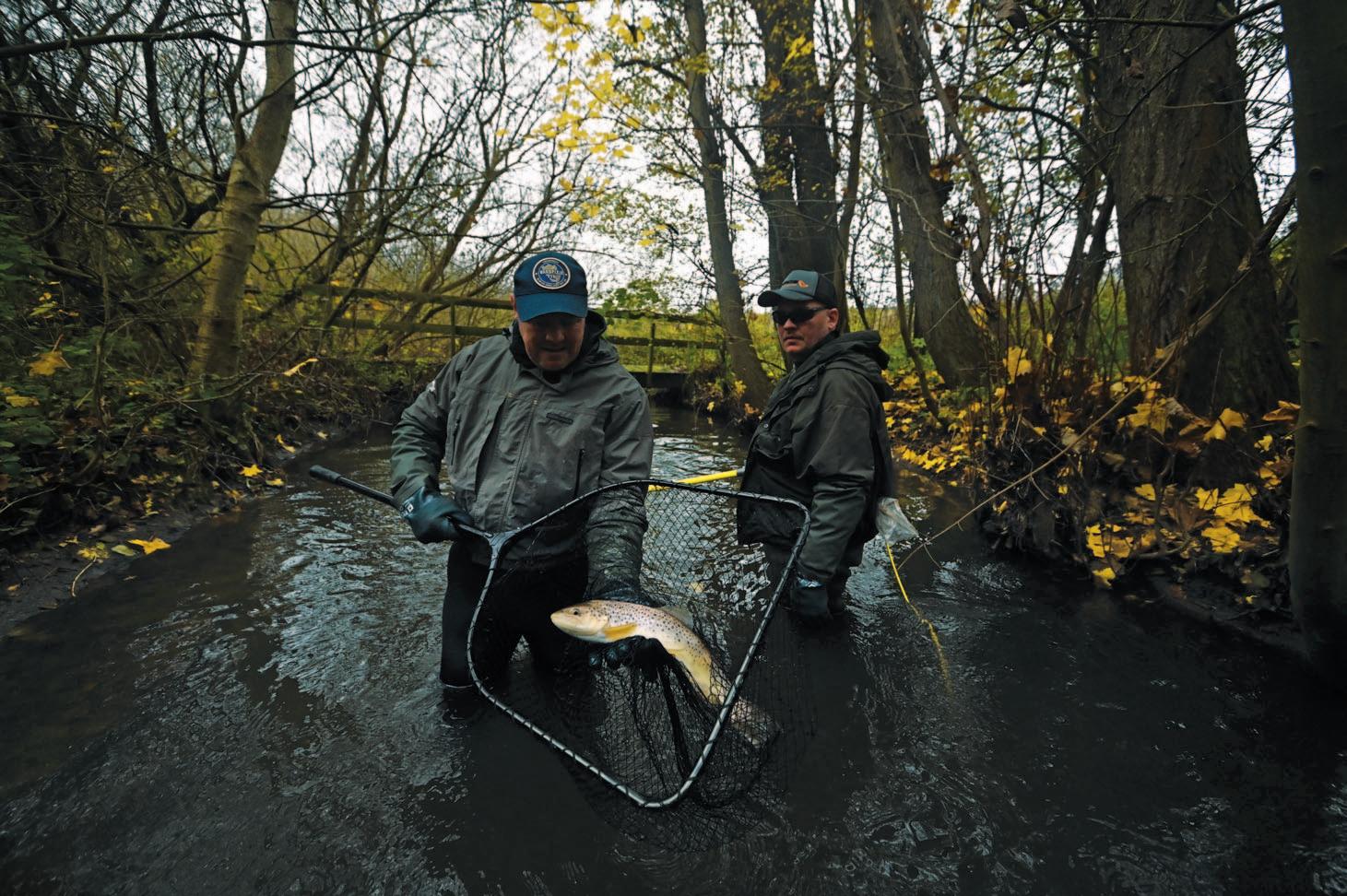
A state fishing permit costs just a few hundred Danish kroner a year. The turnover generated by visiting anglers (accommodation, food, petrol, fishing tackle, etc) is essential for Havørred Fyn’s continued existence.

“... A SEA TROUT ON FUNEN HAS A SOCIOECONOMIC VALUE OF DKK 2500/KG (± R6700).”
Left: Trout numbers in Funen have increased to such an extent that the stocking efforts can now be reduced, and allow the fish population to fend for itself as genetically wild stock.

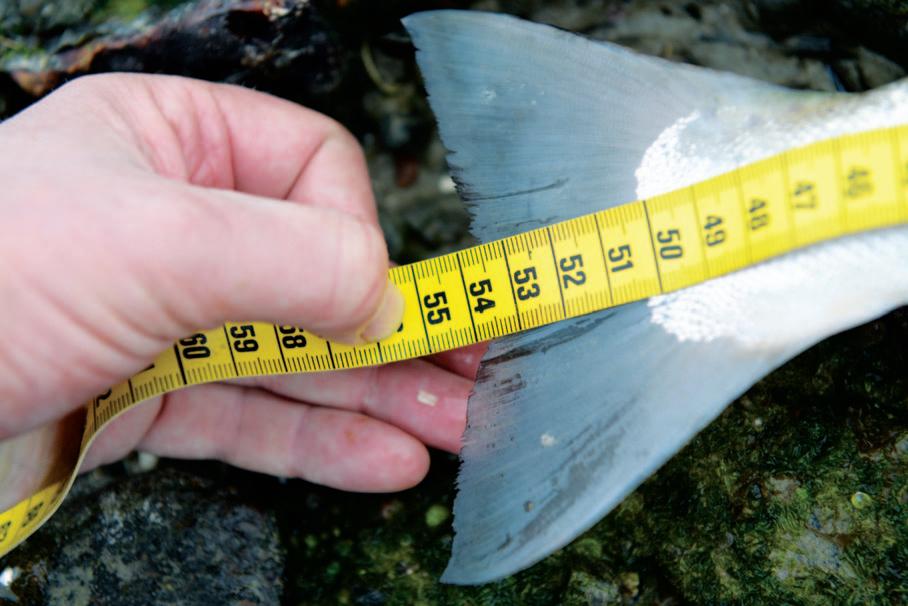
Below: Some of the Havørred Fyn team busy stocking a stream.

Next page: Teams hard at work depositing gravel to help create new spawning beds.

SATISFACTORY RESULTS
Sea trout respond to newly restored spawning beds in a watercourse almost immediately. Sometimes the excavators have barely left and the trout would begin to lay their precious eggs in the gravel. It does not take much more than clean water, access to spawning gravel, and hiding places for when the fry swims upstream from the gravel in the spring. The effects of Havørred Fyn’s efforts are monitored on an ongoing basis, and over the project’s 30-year history, we have seen more and more watercourses with fry, and the number of fry on the individual stretches growing exponentially.

IN SUMMARY
Trout numbers in Funen have increased to such an extent that we can now start reducing the amount of fish that are stocked, and allow the fish population to fend for itself as genetically wild stock. It is also important to note that, as trout begin to thrive in these rivers and streams, many other aquatic species are also benefiting. A large number of environmentally sensitive fish species and small animals will have a chance to thrive in a healthy and strong aquatic environment, all thanks to the efforts of Havørred Fyn.
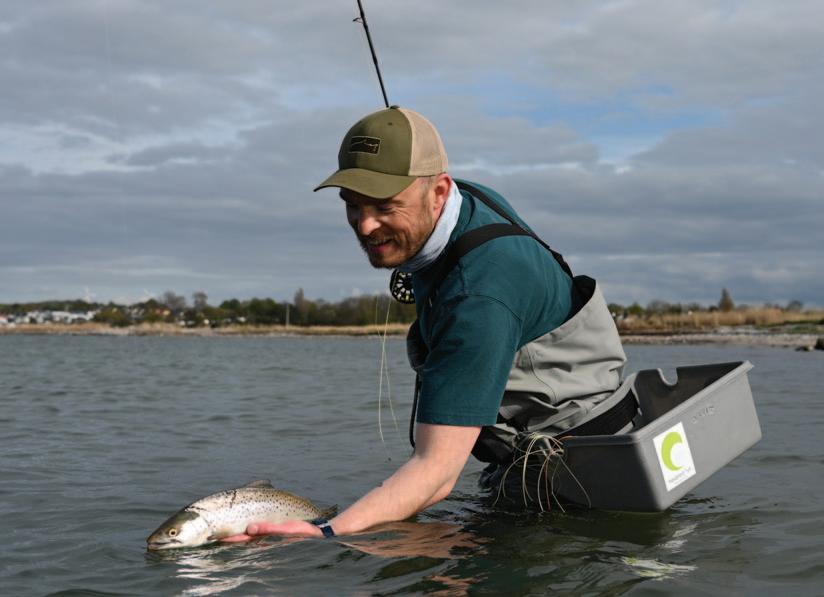

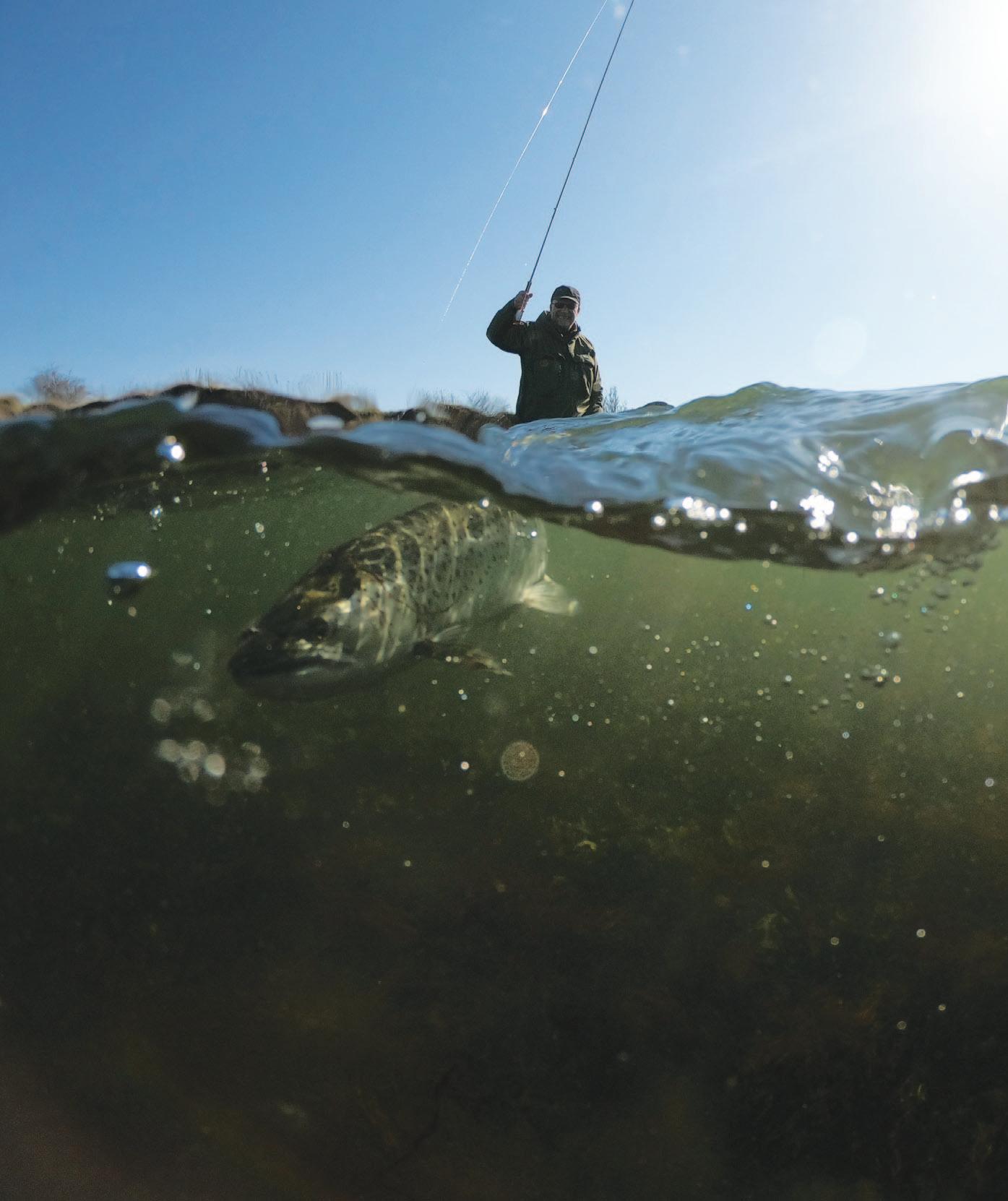
“A LARGE NUMBER OF ENVIRONMENTALLY SENSITIVE FISH SPECIES AND SMALL ANIMALS WILL HAVE A CHANCE TO THRIVE IN A HEALTHY AND STRONG AQUATIC ENVIRONMENT, ALL THANKS TO THE EFFORTS OF HAVØRRED FYN.”
